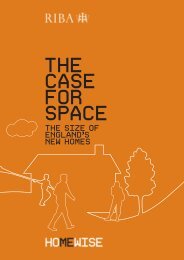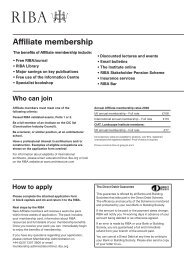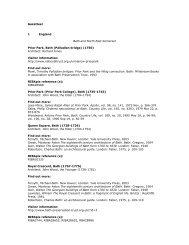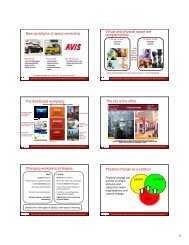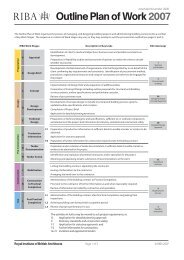Albertopolis Walking Tour: transcript - Royal Institute of British ...
Albertopolis Walking Tour: transcript - Royal Institute of British ...
Albertopolis Walking Tour: transcript - Royal Institute of British ...
Create successful ePaper yourself
Turn your PDF publications into a flip-book with our unique Google optimized e-Paper software.
10. <strong>Royal</strong> College <strong>of</strong> Organists<br />
24.15mins<br />
This unusual building was built in 1874-75 to<br />
accommodate the new National Training<br />
School for Music, later to become the <strong>Royal</strong><br />
College <strong>of</strong> Music. Interestingly the architect<br />
was Lieutenant H.H. Cole, the eldest son <strong>of</strong><br />
Henry Cole, one <strong>of</strong> the main figures behind<br />
South Kensington.<br />
Lieutenant Cole, who gave his services for<br />
free on the project, had great experience and<br />
knowledge <strong>of</strong> Indian archaeology and<br />
architecture. He had also catalogued the casts<br />
for the Indian section <strong>of</strong> the South<br />
Kensington Museum. This interest and<br />
knowledge can be seen in his design, although<br />
his father and members <strong>of</strong> the Science and<br />
Art Department were also consulted.<br />
Cole combined the Old English style <strong>of</strong> the<br />
15 th century, with its large oriel windows,<br />
timber framing and brackets, with Italianate plaster ornament and a polychromatic or multicoloured<br />
façade, resulting in the building having quite a foreign feel.<br />
It was intended that the school contrast with the neighbouring <strong>Royal</strong> Albert Hall, so red<br />
brick and terracotta were avoided. Instead, cream, pale blue and maroon sgraffito, or incised<br />
plaster decoration, was adopted. This decorative scheme was devised by F.W. Moody, who<br />
had also designed for the South Kensington Museum. The frieze features numerous<br />
musicians, reflecting the function <strong>of</strong> the building.<br />
The building and school opened in May 1876, with Sir Arthur Sullivan, <strong>of</strong> Gilbert and<br />
Sullivan fame, as its first principal. In 1883 the School was replaced by the <strong>Royal</strong> College <strong>of</strong><br />
Music, who were already preparing to move to a larger site by 1887. The building stood<br />
vacant from 1896 until 1903 when the <strong>Royal</strong> College <strong>of</strong> Organists took a lease for the site for<br />
99 years.<br />
The organists left the building in 1990. Once again the building remained unoccupied for a<br />
while, but it has now been converted and restored for use as a private house.<br />
To reach the next stop on our walk follow the curving road round to the right, walking<br />
down towards Bremner Road. Turn left on to Queen’s Gate and then take the immediate<br />
first left turning into Prince Consort Road. Walk along Prince Consort Road until you come<br />
to a church on the left hand side.<br />
Pause the recording<br />
<strong>Royal</strong> College <strong>of</strong> Organists, c.1876<br />
Reproduced by permission <strong>of</strong> English<br />
Heritage. NMR<br />
12




